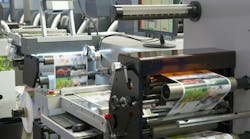“Air conveyor” refers to a family of devices that use air to move products and materials rather than mechanical belts or chains. Air conveyors are most widely used to move lightweight objects such as empty containers, boxes, and trays at speeds often exceeding 1,000 fpm. However, they are not limited to lightweight materials.
Air Conveyor Basics
One major advantage of air conveyors is that they can move easily damaged items like aluminum cans or difficult-to-convey items such as empty two-liter bottles at speeds far greater than conventional conveyors. For example two-liter PET bottles have narrow bases and easily fall over on conventional table-top conveyors at speeds over 50 fps when empty. If the conveyor must start and stop frequently, the top speed must be even lower. The same empty bottles can easily be transported by air conveyors at speeds up to 1,000 fps, and frequent starts and stops have no effect.
Some common air conveyor tasks are moving empty beverage cans and PET bottles. They are also widely used to move scrap such as wood chips, an application in which conventional conveyors would quickly become clogged and contaminated with debris.








